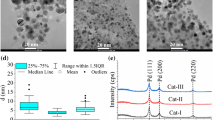Abstract
The effect of the reduction method on the catalytic properties of palladium catalysts supported on activated carbon for the oxidation of D-glucose was examined. The reduction methods investigated include argon glow discharge plasma reduction at room temperature, reduction by flowing hydrogen at elevated temperature, and reduction by formaldehyde at room temperature. The plasma-reduced catalyst shows the smallest metal particles with a narrow size distribution that leads to a much higher activity. The catalyst characteristics show that the plasma reduction increases the amount of oxygen-containing functional groups, which significantly enhances the hydrophilic property of the activated carbon and improves the dispersion of the metal.
Similar content being viewed by others
References
Wang Z, Yang FH, Yang RT. Enhanced hydrogen spillover on carbon surfaces modified by oxygen plasma. J Phys Chem C, 2010, 114:1601–1609
Wang Z, Liu CJ, Zhang GL. Size control of carbon black-supported platinum nanoparticles via novel plasma reduction. Catal Commun, 2009, 10:959–962
Li Y, Yang RT, Liu CJ, Wang Z. Hydrogen storage on carbon doped with platinum nanoparticles using plasma reduction. Ind Eng Chem Res, 2007, 46:8277–8281
Wang LF, Yang RT. Hydrogen storage properties of carbons doped with ruthenium, platinum, and nickel nanoparticles. J Phys Chem C, 2008, 112:12486–12494
Dimitratos N, Lopez-Sanchez JA, Hutchings GJ. Green catalysis with alternative feedstocks. Top Catal, 2009, 52:258–268
Arcadi A. Alternative synthetic through new develoments in catalysis by gold. Chem Rev, 2008, 108:3266–3325
Onda A, Ochi T, Kajiyoshi K, Yanagisawa K. A new chemical process for catalytic conversion of D-glucose into lactic acid and gluconic acid. Appl Catal A, 2008, 343:49–54
Zhu JJ, Figueiredo JL, Faria JL. Au/activated-carbon catalysts for selective oxidation of alcohols with molecular oxygen under atmospheric pressure: Role of basicity. Cata Commun, 2008, 9:2395–2397
Zhou Y, Wang S, Ding B, Yang Z. Preparation of onion-like Pd-Bi-Au/C trimetallic catalyst and their application. J Sol-Gel Sci Technol, 2008, 47:182–186
Sievers C, Musin I, Marzialetti T, Olarte MBV, Agrawal PK, Jones CW. Acid-Catalyzed conversion of sugars and furfurals in an ionic-liquid phase. ChemSusChem, 2009, 2:665–671
Gogova Z, Hanika J. Reactivation of a palladium catalyst during glucose oxidation by molecular oxygen. Chem Papers, 2009, 63:520–526
Yin HM, Zhou CQ, Xu CX, Liu PP, Xu XH, Ding Y. Aerobic oxidation of D-glucose on support-free nanoporous gold. J Phys Chem C, 2008, 112:9673–9678
Liang X, Liu CJ, Kuai P. Selective oxidation of glucose to gluconic acid over argon plasma reduced Pd/Al2O3. Green Chem, 2008, 10:1318–1322
Lu J, Do I, Drzal LT, Worden RM, Lee I. Nanometal-decorated exfoliated graphite nanoplatelet based glucose biosensors with high sensitivity and fast response. ACS Nano, 2008, 2:1825–1832
Mirescu A, Berndt H, Martin A, Prusse U. Long-term stability of a 0.45% Au/TiO2 catalyst in the selective oxidation of glucose at optimised reaction conditions. Appl Catal A, 2007, 317:204–209
Ishida T, Kinoshita N, Okatsu H, Akita T, Takei T, Haruta M. Influence of the support and the size of gold clusters on catalytic activity for glucose oxidation. Angew Chem Int Ed, 2008, 47:9265–9268
Onal Y, Schimpf S, Claus P. Structure sensitivity and kinetics of D-glucose oxidation to D-gluconic acid over carbon-supported gold catalysts. J Catal, 2004, 223:122–133
Liang X, Wang ZJ, Liu CJ. size-controlled synthesis of colloidal gold nanoparticles at room temperature under the influence of glow discharge. Nanoscale Res Lett, 2010, 5:124–129
Tang S, Lu N, Wang JK, Ryu SK, Choi HS. Novel effects of surface modification on activated carbon fibers using a low pressure plasma treatment. J Phys Chem C, 2007, 111:1820–1829
Lee D, Hong SH, Paek KH, Ju WT. Adsorbability enhancement of activated carbon by dielectric barrier discharge plasma treatment. Surf Coat Technol, 2005, 200:2277–2282
Author information
Authors and Affiliations
Corresponding author
Rights and permissions
About this article
Cite this article
Chen, K., Pan, Y. & Liu, C. Effect of reduction method on the performance of Pd catalysts supported on activated carbon for the selective oxidation of glucose. Sci. China Chem. 53, 1598–1602 (2010). https://doi.org/10.1007/s11426-010-4035-7
Received:
Accepted:
Published:
Issue Date:
DOI: https://doi.org/10.1007/s11426-010-4035-7




